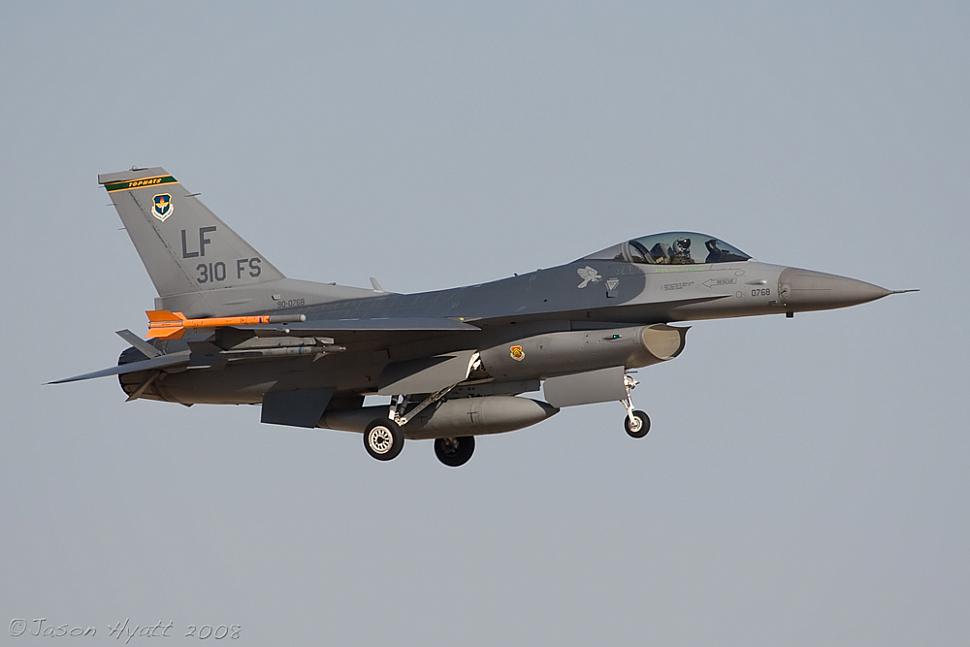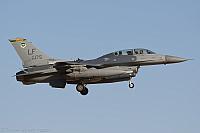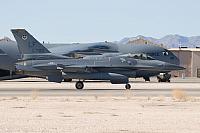Fighter Jet News
F-16 Fighting Falcon News
Mass F-16 launch to fill skies
December 13, 2010 (by
SSgt. Robert Biermann & Jodi Jordan) -
The skies around Luke Air Force Base will be busier than normal Wednesday during Cactus Starfighter, a large force exercise for the 310th Fighter Squadron and 310th Aircraft Maintenance Unit. During Cactus Starfighter, the combined efforts of Luke units will launch more than 30 F-16s at one time.
The exercise will focus on mission planning and coordination in addition to aerial maneuvers. All student pilots in the F-16 Basic Course must participate in similar exercises at the end of their training, but this Cactus Starfighter is unique in the number of aircraft launching simultaneously and the level of coordination required, said Capt. Christopher Hubbard, 310th FS instructor pilot.
The plan is for 36 F-16s to launch from Luke's runway. Of these, 32 will be "good guys" and four will be "bad guys," or aggressors, Captain Hubbard said.
Additionally, a KC-135 tanker aircraft from Altus Air Force Base, Okla., will launch from Luke and provide aerial refueling. Also joining in the exercise are F-15 aggressors from Nellis Air Force Base, Nev., and Marine Corps F-5 aggressors from Marine Corps Air Station Yuma. Providing command and control as well as intelligence gathering are three aircraft from other bases: a joint surveillance target attack radar system aircraft from Warner Robins Air Force Base, Ga.; an airborne warning and control system aircraft from Tinker Air Force Base, Okla.; and an RC-135 rivet joint aircraft from Offutt Air Force Base, Neb.
"It's always a goal to have as many aircraft flying as possible, because historically, in real conflicts, you would have this size of a package," Captain Hubbard said. A package is the combination of air assets a commander sends to battle.
"Unfortunately, we aren't usually able to put this many aircraft in the air," he said. "The size of the exercise force is determined by a host of factors, including maintenance schedules and air space limitations."
A large force exercise like Cactus Starfighter gives the B Course students realistic training in the way they would have to fight in a real-world operation.
The impetus for Cactus Starfighter came when Lieutenant Col. Timothy Trimmell, 756th Aircraft Maintenance Squadron commander, issued a challenge to the maintainers of the AMUs here.
"In September, Colonel Trimmell challenged the AMUs to 'launch the fleet,' i.e., see which AMU could be the first to launch all their aircraft at once," said Capt. Joshua Downing, 310th AMU officer-in-charge. "We're meeting that challenge."
Regularly scheduled maintenance would normally preclude such a large launch of aircraft, Captain Downing said. In a normal week, at least three or four of the jets assigned to the 310th AMU aren't flying because of maintenance schedules. Also, the sheer numbers of maintaners needed to launch 20-plus aircraft required special consideration, he said.
The coordination process to perform has included the 308th and 310th FSs, 56th Operations Support Squadron air traffic controllers, 56th Maintenance Operations Squadron end-of-runway crews, 56th Fighter Wing plans and scheduling, and other AMUs.
Also helping to put the exercise together are the Airmen of the 56th Operations Group Intelligence Flight. The flight is responsible for providing intelligence briefings to the fliers on all aspects of the different threats and weapons systems they will be simulating combat against during Cactus Starfighter. "Basically, we come up with all the plans to ensure the pilots can defeat the threat, do their job and come back home safely," said 1st Lt. Chad Haring, 56th OG Intelligence Flight systems chief.
More aircraft means more pilots to brief.
"Instead of briefing two or four people across a table, we will be briefing a room full," he said. "Our mission is the same, but the volume and quantity changes. We have to be very precise in making sure each individual gets the information."
The event is going to include many assets, according to Captain Downing.
"This exercise will use all the resources we have," he said. "The nearly 260 Airmen assigned to the AMU will assist with the launch and recovery of the jets."
At least four jets will take off at a time, with a five to 10-minute gap until the next series takes off. Once all jets are in flight, they'll be airborne for nearly an hour and a half.
"The 'launch the fleet' large force exercise will be an epic celebration of TopHats history to have all TopHats airborne at once," said Lt. Col. Sean Routier, 310th FS director of operations. "Since it formally joined Luke Dec. 15, 1969, it's been training pilots and weapon systems officers."
The plan is for 36 F-16s to launch from Luke's runway. Of these, 32 will be "good guys" and four will be "bad guys," or aggressors, Captain Hubbard said.
Additionally, a KC-135 tanker aircraft from Altus Air Force Base, Okla., will launch from Luke and provide aerial refueling. Also joining in the exercise are F-15 aggressors from Nellis Air Force Base, Nev., and Marine Corps F-5 aggressors from Marine Corps Air Station Yuma. Providing command and control as well as intelligence gathering are three aircraft from other bases: a joint surveillance target attack radar system aircraft from Warner Robins Air Force Base, Ga.; an airborne warning and control system aircraft from Tinker Air Force Base, Okla.; and an RC-135 rivet joint aircraft from Offutt Air Force Base, Neb.
"It's always a goal to have as many aircraft flying as possible, because historically, in real conflicts, you would have this size of a package," Captain Hubbard said. A package is the combination of air assets a commander sends to battle.
"Unfortunately, we aren't usually able to put this many aircraft in the air," he said. "The size of the exercise force is determined by a host of factors, including maintenance schedules and air space limitations."
A large force exercise like Cactus Starfighter gives the B Course students realistic training in the way they would have to fight in a real-world operation.
The impetus for Cactus Starfighter came when Lieutenant Col. Timothy Trimmell, 756th Aircraft Maintenance Squadron commander, issued a challenge to the maintainers of the AMUs here.
"In September, Colonel Trimmell challenged the AMUs to 'launch the fleet,' i.e., see which AMU could be the first to launch all their aircraft at once," said Capt. Joshua Downing, 310th AMU officer-in-charge. "We're meeting that challenge."
Regularly scheduled maintenance would normally preclude such a large launch of aircraft, Captain Downing said. In a normal week, at least three or four of the jets assigned to the 310th AMU aren't flying because of maintenance schedules. Also, the sheer numbers of maintaners needed to launch 20-plus aircraft required special consideration, he said.
The coordination process to perform has included the 308th and 310th FSs, 56th Operations Support Squadron air traffic controllers, 56th Maintenance Operations Squadron end-of-runway crews, 56th Fighter Wing plans and scheduling, and other AMUs.
Also helping to put the exercise together are the Airmen of the 56th Operations Group Intelligence Flight. The flight is responsible for providing intelligence briefings to the fliers on all aspects of the different threats and weapons systems they will be simulating combat against during Cactus Starfighter. "Basically, we come up with all the plans to ensure the pilots can defeat the threat, do their job and come back home safely," said 1st Lt. Chad Haring, 56th OG Intelligence Flight systems chief.
More aircraft means more pilots to brief.
"Instead of briefing two or four people across a table, we will be briefing a room full," he said. "Our mission is the same, but the volume and quantity changes. We have to be very precise in making sure each individual gets the information."
The event is going to include many assets, according to Captain Downing.
"This exercise will use all the resources we have," he said. "The nearly 260 Airmen assigned to the AMU will assist with the launch and recovery of the jets."
At least four jets will take off at a time, with a five to 10-minute gap until the next series takes off. Once all jets are in flight, they'll be airborne for nearly an hour and a half.
"The 'launch the fleet' large force exercise will be an epic celebration of TopHats history to have all TopHats airborne at once," said Lt. Col. Sean Routier, 310th FS director of operations. "Since it formally joined Luke Dec. 15, 1969, it's been training pilots and weapon systems officers."
Courtesy of 56th Fighter Wing Public Affairs
Additional images:
Related articles:
Forum discussion:
Tags
- 309th FS & AMU return from exercise (2010-11-05)
- Luke team trains for combat at Red Flag-Alaska (2007-04-12)
- F-16 Fighting Falcon news archive
Forum discussion:
- Start a discussion about this article in the F-16.net forum.
Tags



